On January 1, 2026, as part of a provincial regulation, a new provider will collect residential recycling.
Beginning January 1, 2026, the City will no longer be responsible for collecting residential recycling. A new recycling service provider, Circular Materials, will be responsible for recycling collection and related services. As required by provincial regulation (O. Reg. 391/21 – Blue Box), producers of blue box materials are fully financially and operationally responsible for providing recycling services to residential locations, eligible multi-residential buildings, schools, long-term care facilities and retirement homes. The City will still be responsible for collecting and managing recycling from its commercial customers; City Divisions and Agencies; Charities, Institutions and Religious Organizations.
Until December 31, 2025, there are no changes to your current residential recycling routine. For any recycling collection services, such as missed collection or blue bin repair, please continue to contact 311 in 2025.
Starting January 1, 2026, for recycling inquiries including missed collection and blue bin service requests, please call 1-888-921-2686 or visit Circular Materials.
Blue Bin Stickering
As part of the changes to the Blue Bin program, a sticker has been applied to Blue Bins at all residential properties. Learn more about Blue Bin stickering.
Background
In 2021, the Province of Ontario finalized the regulation to transition Ontario’s Blue Box Program to full Extended Producer Responsibility (EPR). Toronto’s Blue Bin recycling program transitioned to EPR as of July 1, 2023.
EPR makes producers fully accountable for the management of paper products, packaging and packaging-like products that they put into the Ontario marketplace and shifts the operational and financial responsibilities of recycling away from municipalities.
Benefits of EPR
The benefits of EPR include:
- standardization of what is accepted in the Blue Box across the province as of 2026 when producers have fully taken over recycling
- potential for increased waste diversion from landfill once recovery targets come into effect in 2026 and onwards
- potential reduction and/or innovation in packaging.
Items Accepted in Recycling until December 31, 2025
Beginning January 1, 2026, there will be changes to the materials accepted in the new Blue Bin recycling program. For more information, visit Circular Materials.
Glass
- Bottles, jars (lids on)

Rigid Plastics
- Food jars, tubs (lids on)
- Clear food containers/clamshells (e.g. from berries, vegetables, mixed greens)
- Disposable plastic cups
- Beverage bottles (lids on)
- Salad dressing bottles
- Detergent, soap, shampoo bottles (lids/sprayers/pumps on)
- Clear CD/DVD cases (empty; black cases are garbage)
Note: all black and/or compostable plastic goes in the garbage.
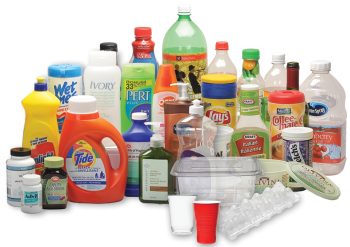
Soft, Stretchy Plastics
- Grocery/retail shopping bags
- Produce/bulk food bags
- Bread bags (non-foil)
- Milk bags (outer bag, rinsed inner pouches)
- Sandwich bags (including resealable)
- Frozen fruit/vegetable bags (no stand-up pouches)
- Over-wrap (e.g. from toilet paper, napkins, paper towels, water/soft drink cases)
- Newspaper/flyer/magazine bags (separate paper from bag, recycle separately)
- Dry cleaning bags
- Diaper/feminine hygiene outer bags
- Garden soil/manure/compost/road salt bags
Note: remove product before recycling.
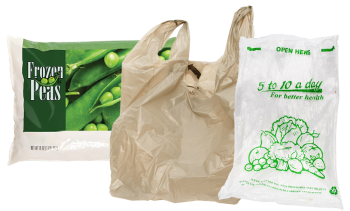
Metal
- Aluminum/steel food & beverage cans
- Aluminum trays, burner liners, pie plates, roasting pans
- Cookie tins
- Aerosol cans (empty; lids on)
- Paint cans (empty; remove lids and recycle separately)
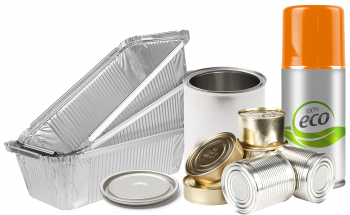
Paper*
- Bags (without wax or plastic lining/coating)
- Advertising mail, fine paper, envelopes
- Newspapers, flyers, directories, magazines, catalogues (remove over-wrap, recycle separately)
- Gift wrap, tissue paper, cards (no ribbons, bows, foil wrap)
- Shredded paper (put in clear plastic bag, tie closed)
- Soft/hard cover books
*Place pieces smaller than a business card in envelope or add to bag of shredded paper.
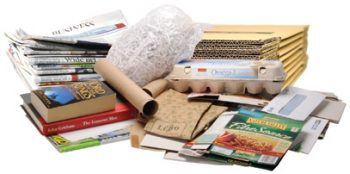
Paper Containers
- Cartons and boxes (e.g. from juice, milk, soup; straws are garbage)
- Spiral wound cans (e.g. from chips, nuts, frozen juice – place metal end in can and pinch closed; pull-off strips are garbage)
- Paper-based and plastic-lined hot and cold beverage cups
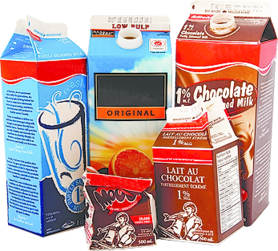
Cardboard
- Boxboard (e.g. from cereal, tissue, detergent, shoe; remove liners, flatten, no freezer boxes)
- Corrugated cardboard (unwaxed, flattened; pizza boxes must be empty; remove over-wrap from water/soft drink cases, recycle separately)
- Rolls (e.g. from toilet paper, paper towel, wrapping paper)
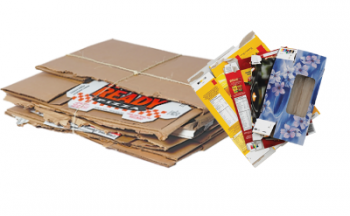
Foam Polystyrene
- Foam food and protective packaging (e.g. plates, cups, egg cartons, takeout containers, meat/fish trays; plastic wrap & absorbent pad are garbage)
- Protective packaging (e.g. from shipping, electronics; foam packaging peanuts are garbage)
Note: Food/drink packaging must be empty and rinsed (otherwise, place in garbage). Black foam items and pieces smaller than 10 cm (4″) x 10 cm (4″) go in the garbage).
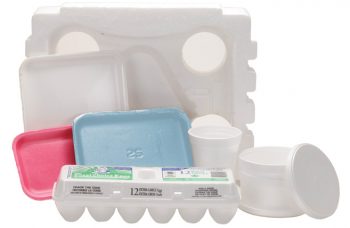
Items Not Accepted in Recycling until December 31, 2025
Beginning January 1, 2026, there will be changes to the materials accepted in the new Blue Bin recycling program. For more information, visit Circular Materials.
Medical, Home Healthcare & Personal Protective Equipment Waste
- Needles and syringes are Household Hazardous Waste.
- Place the following inside two plastic bags and then in the garbage:
- Disposable masks, gloves, gowns, pads
- Soiled dressing, sponges, gauze
- Catheters & colostomy bags
- IV bags & tubing
- Dialysis waste
Household Hazardous Waste
- Household hazardous waste items such as propane/helium tanks, batteries, compact fluorescent light bulbs, pesticides, paint, etc. must never be put in recycling or garbage.
- Take to a Drop-Off Depot or for amounts between 10 to 50 litres/kilograms, book a free Toxic Taxi pickup online or by calling 311.
Plastic Packaging
- Any items that are black, including takeout containers, bags, plant trays and flower pots
- Any items that are labelled or marketed as compostable or biodegradable, including bags, containers, cutlery
- Stand-up resealable pouch bags
- Liner bags (e.g. from cereal, cookies, crackers)
- Wrapping around pre-packaged foods like meat and cheese
- Food wrap (i.e. Cling wrap)
- Bubble wrap
- Pet food bags
- Squeeze tubes for home and personal products (e.g. from toothpaste, lotion)
- Paint cans
Other Plastic
- Straws
- Clothes hangers
- Binders
- Toys
- Cassettes, CDs, DVDs
Glass
- Drinking glasses, dishes, cups, crystal
- Ceramics, pottery
- Window glass
- Light bulbs
- Mirrors
- Pots, pans
Metal
- Tools, scrap metal, auto parts
- Clothes hangers
- Pots, pans
- Small appliances (e.g. kettles, toasters, hair dryer)
- Electronics
Aluminum
- Foil food wrap, potato chip bags
- Blister packs (e.g. from gum, pills)
- Metallic gift wrap and bows
Textiles
- Clothes, shoes
- Carpets, curtains
- Bedding
Paper Products
- Tissues, napkins, paper towels
- Frozen food boxes (they have a lining or coating)
- Waxed cardboard
Other Items
- Cables, hoses, ropes
- Wood (e.g. fruit crates, chopsticks)
- Renovation waste (must be taken to a Drop-Off Depot)
General Recycling Instructions until December 31, 2025
- Put items in loose and not bagged. Use a clear plastic bag only if necessary.
- Prepare containers in 3 easy steps:
- empty food, liquids or other contents
- rinse to remove any residue
- place lid/cap on (including sprayers and pumps)
- Place all black and/or compostable plastic (e.g. food containers, bags, cutlery) in the garbage.
- Flexible multi-layered packaging (e.g. stand-up pouches) and plastic-lined paper
(e.g. instant oatmeal packs) go in the garbage. To check if paper is lined with plastic, rip it slowly. If you see any plastic lining, the item goes in the garbage.
- Separate plastic bags/over-wrap from newspapers, flyers, magazines, water/soft drink cases. Recycle separately.
- Put shredded paper in a clear plastic bag.
- Put pieces of paper the size of a business card or smaller in an envelope or add to clear bag of shredded paper.
- Put foam pieces smaller than 10 cm (4″) x 10 cm (4″) in the garbage.
- Not all items with a recycling symbol
 are accepted in Toronto’s Blue Bin recycling program.
are accepted in Toronto’s Blue Bin recycling program.
- If unsure about whether or not an item can be recycled, check Waste Wizard.
Common Recycling Mistakes
Food and organic waste
Food scraps like apple cores, eggshells or expired leftovers belong in your Green Bin. When you mistakenly toss food scraps in your Blue Bin, food residue and particles get soaked up by paper and can ruin large batches of otherwise good recyclables.
Containers with leftover food
Please empty and rinse food containers before tossing them in your Blue Bin. When you don’t, the residue from items like jars and take-out containers gets soaked up by paper and can ruin large batches of otherwise good recyclables. Put any food scraps in your Green Bin.
Clothing and textiles
Old clothes, shoes, blankets, and curtains don’t belong in the Blue Bin. They can get caught in sorting machines, damage equipment and cause workplace injuries at the recycling facility. Instead, donate items that are in good condition to not-for-profit agencies or drop them off for reuse at Community Environment Days. If your items can’t be donated, put them in the garbage.
VHS tapes, chains, hoses and electrical cords
These do not go in your Blue Bin. They can get tangled in sorting machines, damage equipment and cause workplace injuries at the recycling facility. Donate unwanted VHS tapes or see if your local electronics store’s has a recycling program. Throw unwanted cords, hoses and cables in your garbage.








